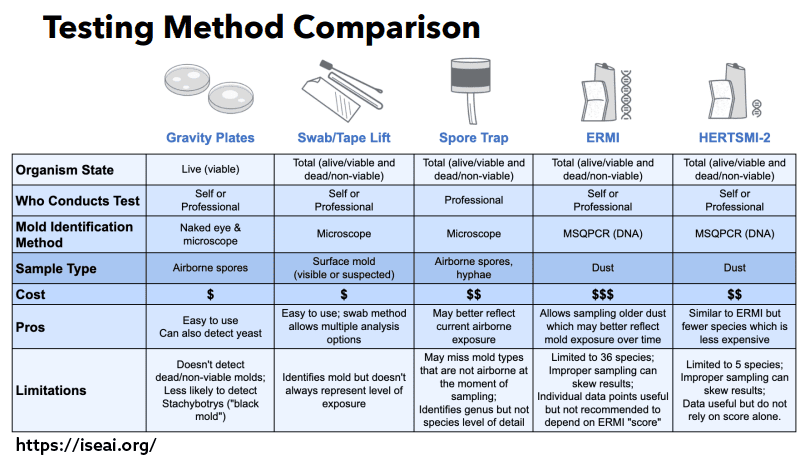Review current mould testing and remediation options to help navigate these sometimes confusing, expensive, and often life-changing conversations.
A number of mysterious and unexplainable symptoms may result in your healthcare provider suspecting mould as an underlying factor contributing to ill health. A MycoTOX Profile and Organic Acids Test (OAT) can be ordered to understand the potential of mould exposure, and how this exposure is impacting your body’s metabolic functionality. The first step to support recovery is to identify and remove the exposure.
Well, that’s easier said than done!
This is because in our active, varying lives, other buildings we frequent like work or school, and even cars may be sources of exposure. It is not always the current home! Keeping this fact in mind is crucial to a well-rounded mould inspection.
Our goal with this blog will be to summarise the current mould testing and remediation options you can consider, to help navigate these sometimes confusing, expensive, and often life-changing conversations.
For more information on mould, mycotoxins, and their impact on health, continue reading.
Mould Testing and Remediation Overview
Currently, the mould testing and remediation industry is still young, and will undoubtedly adapt and change as the awareness of mould-related illness grows. There are no “gold standards” or even any standardisation of what defines acceptable or unacceptable levels of mould, mould spores and mycotoxins.
Additionally, it must be stated that remediation for sensitive patients goes well beyond current industry practices. Sensitive patients may still be reactive in a house that has been remediated but lacked proper post-remediation cleanup. Or perhaps the remediation was conducted in a way that during the process, other areas of the house were contaminated.
So given this uncertainty, where to begin?
Below, we will describe some common mould testing options to consider prior to having a certified professional come in to evaluate your space
Mould Sabbatical & Home Testing Options
The most cost-effective option is an environmental sabbatical. This simply involves leaving the suspected exposure for 3-7 days in a clean location. Ideally where other mould-sensitive individuals have not been reactive in the past. Keep in mind that many hotels, holiday houses and even friends and family’s homes may be sources of mould contamination.
Choose your location wisely and assess for any symptomatic improvement. An important practice is to avoid bringing any personal items from the suspected contaminated home as these could also be sources of exposure.
Common mould sabbatical options:
- Setting up a backyard tent or camper
- Renting a holiday house
- Taking a mini vacation
If after leaving the area of concern, there were symptomatic improvements, the second step is ruling the home in or out.

Mould Testing Methods
ERMI/ HERTSMI
The Environmental Relative Mouldiness Index (ERMI) was developed by the EPA’s Office of Research and Development (ORD) as a research tool to investigate mould contamination in homes. The testing used is a mould-specific quantitative polymerase chain reaction (MSQPCR) method that quantifies 36 moulds and calculates a score of relative mouldiness as compared to the reference homes. The score can range from negative ten (-10) to positive twenty (20). The test is conducted using a vacuum to collect dust before sending the sample for analysis. For homes sans carpet, a Swiffer method is used.
The HERTSMI is a less expensive option, utilising the same collection and testing methods, but for only 5 of the more common indoor mould species.
Pros
- Often described as a “snapshot in history” of water damage in a home.
- PCR method is very precise, and can detect small mould fragments, often missed with other testing methods (e.g., Stachybotrys)
- ERMI is frequently referred to as the preferred test for treating mould illness and is utilised frequently by mould-literate clinicians
Cons
- The test is not suited for detecting the source of where the mould is coming from, as the dust sampled throughout the house is combined during collection
- ERMI may miss extensive damage if only one area of the house is contaminated, due to the wide distribution of spores
- Just because an ERMI test comes back with a low score, this doesn’t necessarily mean the house is clean. You and your practitioner should always evaluate the spore count in addition to the score.
Spore traps/Air Sample
Spore traps are the current industry standard for mould testing, utilising a pre-calibrated air-flow rate device that samples the air over a pre-determined amount of time, typically 1-5 minutes. The indoor sample is then compared to air quality samples taken from non-compliant locations or outside.
Pros
- Primarily used by professional inspectors, and thought to be more standardised than other methods
- Often necessary for identifying sources of mould growth
- Able to detect more species than ERMI/HERTSMI
Cons
- Results can be impacted by improper testing methods
- Only utilised by professionals
- May miss unseen mould growth if the concentration of spores in the air is low during the collection time.
- Will only test for viable organisms (i.e., intact mould spores, bacteria, yeast)
Testing visible mould growth can be done by removing portions of contaminated building, or sampling surfaces with a sterile swab or tape.
Bulk material and surface tests
Pros
- Testing damaged materials can detect far more species than ERMI
- Able to identify moulds that may not be present in the air
- Little to no equipment is needed
- Useful for assessing sources of mould that will need to be removed, repaired, or cleaned
Cons
- Bulk material testing is usually biased toward viable organisms
- Risk of releasing mould spores into the air when removing contaminated material
- Does not assess airborne exposure
Gravity plates
Plates can sample dust and mould spores suspended in the air after being placed in a suspected area for a predetermined amount of time. Plates showing mould growth can be sent for laboratory analysis.
Pros
- Cost-effective entry point to creating a testing and remediation plan
- Diverse uses for testing (e.g., able to test the home, car, furniture, carpeting etc.)
- Good option to assess long-term remediation success
Cons
- Prone to false negatives due to poor air circulation
- May miss heavier mould species that are often not airborne (e.g., Stachybotrys)
- Less precise than spore traps in identifying the source
- Only able to detect viable organisms
DIY Testing – Best practices
- Collect as many samples as your budget allows
- Collect samples from areas that you know, or suspect had water damage
- Collect samples from areas that you spend the most time in
- Swab all potential visible mould
- Note areas with strange smells or that feel weird
DEFINITIONS
Viable – agent is alive and can grow in suitable conditions.
Non-viable – agent is not alive, and as such, will not grow despite favourable conditions.
Working with an expert
Mould remediation is an expensive process, and deciding whether to work with a professional or DIY should be taken on a case-by-case basis. While there is no correct answer, there are considerations anyone beginning this process should be aware of. Also, be aware that in many cases homeowners do not remediate effectively and can make themselves sicker in the process. Consulting a professional should always be the first before ever considering a DIY option.
Mould inspectors – vet who you work with
Mould inspectors are often either microbiologists or someone with experience in the industry. While there are certifications currently available, the reality is all mould inspectors are not created equal.
Types of inspectors commonly found:
Visual inspectors – professionals who assess for signs of water damage and mould growth. This approach is not ideal and will miss unseen mould issues.
Air inspectors – air testing is the most widely used approach for testing mould, and despite its limitations, is one of the best ways to identify sources of mould growth.
Home health consultants – the third category is professionals who will utilise several tests to fully evaluate the home. They are well-versed in helping individuals suffering from mould-related illness and go beyond current industry standards.
Resources to consider
- Home Health Consultants and Mould Professionals
- Air Filters – although they will not address mould growth they will improve air quality by reducing the concentration of mould spores
Webinars
- Ter Kuile MM, Vigeveno D, Laan E. Preliminary evidence that acute and chronic daily psychological stress affect sexual arousal in sexually functional women. Behav Res Ther. 2007 Sep;45(9):2078-89. doi: 10.1016/j.brat.2007.03.006. Epub 2007 Mar 19. PMID: 17481578.
- Hamilton LD, Meston CM. Chronic stress and sexual function in women. J Sex Med. 2013 Oct;10(10):2443-54. doi: 10.1111/jsm.12249. Epub 2013 Jul 10. PMID: 23841462; PMCID: PMC4199300.
- Fiala L, Lenz J, Sajdlova R. Effect of increased prolactin and psychosocial stress on erectile function. Andrologia. 2021 May;53(4):e14009. doi: 10.1111/and.14009. Epub 2021 Feb 17. PMID: 33595132.
- Hoyt MA, Gaffey AE, Wang AW, Litwin MS, Lawsin CJ. Sexual well-being and diurnal cortisol after prostate cancer treatment. J Health Psychol. 2020 Sep;25(10-11):1796-1801. doi: 10.1177/1359105318772655. Epub 2018 Apr 26. PMID: 29696999; PMCID: PMC6309533.
Share:
Related Posts

Thorne Celebrates 40 Years of Good Health
Maggie Chandler April 12, 2024 As it’s often said at Thorne, healthy ageing is a gift. It’s about embracing the way you feel, your experiences,

Healthy Coffee Alternatives: When to Quit Coffee & What to Drink Instead
Dr Thomas Wnorowski February 16, 2024 Key Points: Does the idea of quitting coffee make you feel all sorts of (terrible) things? It’s common. But

How Your Social Network Impacts Your Mental Health
Austin Ruff April 17, 2024 Humans are inherently social creatures. It’s in our nature to connect and want to be connected to the people around

Microbiota-Gut-Brain Axis: Behaviour and Dementia Implications
People take supplements to improve or optimize their health. So what happens when you look at the label, and the ingredient list is filled with

Gut Bacteria and GABA
People take supplements to improve or optimize their health. So what happens when you look at the label, and the ingredient list is filled with


